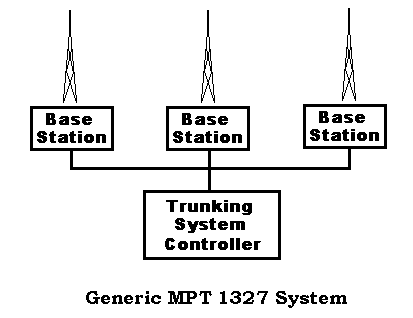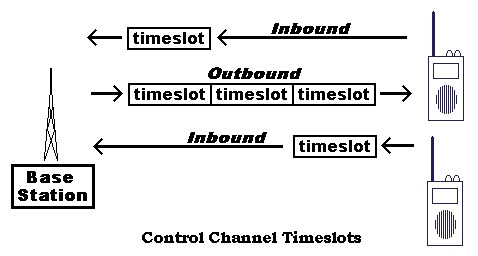Scanner listeners in the United States typically encounter one of the "big three" trunked radio systems, either Motorola, Enhanced Digital Access Communication System (EDACS), or Logic Trunked Radio (LTR). These radio formats are supported by scanner manufacturers and are relatively easy to monitor.
However, there are many other trunked radio systems operating in the world, and this month we'll take a look at one of them.
MPT 1327
In the early 1980's the Department of Trade and Industry in the United Kingdom wanted government agencies to be able purchase radio equipment from different manufacturers yet have them all work together. The Department felt that competition was healthy and would eventually provide the best value to the user. None of the existing systems they examined were acceptable, mainly because the UK wanted a non-proprietary standard that could be used by anyone without restriction.
So the UK government set about creating an open standard. In return for the cooperation of a number of equipment manufacturers, the government reallocated the old Band III television frequencies (175 MHz to 225 MHz) for public access trunked radio.
Manufacturers including GEC Marconi, Motorola, Philips and Tait joined a consortium and over a five-year period produced a series of technical specifications for a trunked radio system. These specifications begin with "MPT" (Ministry of Post and Telegraph) and are referenced by a document number. Document 1327, along with several other documents, lay out the signaling, protocols, and interfaces that make up the core of a "MPT 1327" radio system.
The first base station began full operation from London in 1987 and soon afterward a number of MPT 1327 systems were operating in Europe. Several Asian nations now have MPT 1327 networks, as do Australia, Canada, Mexico, and South Africa.
Proponents claim it is the most popular trunking radio format in the world, except for the United States. They charge that Motorola has prevented the widespread adoption of MPT 1327 in U.S. in order to benefit sales of their proprietary systems, such as Privacy Plus and SmartNet. Since the MPT 1327 protocol is open and essentially unencumbered (outside of the U.S.) by intellectual property claims, many manufacturers produce MPT 1327 equipment and users have many vendors from which to choose. Inside the U.S., however, Motorola holds patents on key parts of MPT 1327 and has, in effect, prevented MPT 1327 from become widespread in their home country. Interestingly, Motorola actually builds a significant number of radios for MPT 1327 systems, however, they are for use outside of the United States.

MPT 1327 Control Channels
As with most trunked radio systems, MPT 1327 has both control and voice channels.
A control channel continuously transmits digital information from a base station to mobile radios (the outbound or forward direction) at 1200 bits per second using a method known as fast frequency shift keying (FFSK). Over the air, data bits are represented as audio tones, with a 1200 Hz tone acting as a '1' and an 1800 Hz tone acting as a '0' bit.
The control channel is divided up into timeslots, each containing 128 data bits. Since the bit rate is 1200 bits per second, a timeslot is about 107 milliseconds (just over a tenth of a second) in duration.
Each of the 128-bit control channel timeslots contains a message with instructions for one, some, or all of the mobile radios that are listening. These messages include:
| ALOHA | The base station is ready to accept a call request. |
| AHOY | The base station is calling a mobile radio. |
| ACKNOWLEDGE | The message has been received. |
| CLEAR | End the call (referred to as a "clear down" or "tear down"). |
| GO TO CHANNEL | Instruct a mobile radio to switch to a particular channel. |
| REQUEST |
A mobile request to start ("set up") a call. |
When a mobile radio isn't busy doing something, it will be tuned to the control channel and decoding the messages coming from the base station. When a mobile sends a message to the base station it will be on the inbound (or reverse) control channel.
ALOHA from Hawaii
As a sidebar, you may notice that the word "ALOHA" is an odd choice for a message word. It actually comes from a series of communication experiments performed at the University of Hawaii in the late 1960s and early 1970s. In those experiments, a central computer transmitted messages to a number of remote transceivers on a single radio frequency. These remote transceivers all communicated back to the central computer on a second, shared radio frequency. One of the problems that surfaced was what if more than one remote transceiver wanted to use the shared frequency at the same time?
In the original system, called ALOHA, a remote transceiver simply transmitted whenever it wanted to. If it was the only one transmitting, the central computer received the message just fine and would transmit an acknowledgment back to the sender. The sender would then know that the message got through correctly.
If, on the other hand, another remote transceiver decided to transmit while the first one was transmitting, the central computer would receive only a garbled message and would not send any acknowledgments. If a remote transceiver did not get an acknowledgment back after transmitting, it was programmed to wait a random amount of time and transmit the message again. Since the random time intervals would in all probability be different for each sender, their next transmissions would most likely not interfere with each other.
A refinement of this system specified that the remote transceivers had to start their transmissions only at certain intervals, all synchronized to each other by a timing signal sent from the central computer. This further reduced the likelihood of interference and doubled the performance of the system. This refinement became known as "slotted ALOHA" and the first, simpler method was called "unslotted ALOHA."
And that's how part of Hawaii came to the United Kingdom.
ALOHA and Timeslots
Anyway, a MPT 1327 base station transmits ALOHA messages on the
outbound channel indicating the number of inbound control channel
timeslots that are available for mobiles to use. In a relatively quiet
system, this number would be 1, meaning the next timeslot is available.
As the load on the system increases, this number may go to 2, meaning
the next two timeslots are available. A mobile requesting service would
randomly select one of two inbound timeslots in which to transmit.
This effectively spreads the inbound load and reduces the chance of
two mobiles interfering with each other (a collision, or call
clash).

Here's a simple example of how a typical call might progress in a MPT 1327 system.
- A mobile radio wishes to contact another mobile radio.
- The calling mobile listens to the outbound control channel for the ALOHA message. It selects the proper inbound timeslot in which to transmit.
- At the proper moment, the calling mobile transmits a REQUEST with the identity of the second mobile.
- The base station responds by transmitting an AHOY message with the identity of the second mobile on the outbound channel.
- The calling mobile hears the AHOY and knows that its request was received.
- The second mobile hears the AHOY and transmits an ACKNOWLEDGE to the base station.
- The base station transmits a GO TO CHANNEL command to the mobiles, instructing them to retune to a voice channel and start their conversation.
A single control channel can typically support about two dozen voice channels and can operate in one of two ways, either dedicated or non-dedicated. A dedicated control channel is permanently available for signaling. A non-dedicated control channel may be used for traffic (voice or data) if all the other channels are busy. Typically a system with only a few channels may choose to use a non-dedicated control channel, while a system with many channels will have one or more dedicated control channels.
MPT 1327 itself can support as many as 1,024 radio channels, which leaves quite a bit of room for expansion. It also allows for more than 32,000 system identities and over a million unit addresses, which can be used for either individuals or groups. A mobile address is made up of a seven-bit prefix in the range 000 to 127 and a 13-bit identity between 2 and 8,100. A mobile radio may be programmed with several addresses for individual identification and group affiliation. In addition, a MPT 1327 radio also contains a 38-bit security number that does not change and can be checked over the air.
Under MPT 1327, radios can make a number of different types of calls, including speech (normal or high priority), group calls, announcements, data, emergency, status messages and short data messages.
Monitoring MPT 1327
Although few and far between, a number of MPT 1327 systems are currently operating in the United States, including Missouri, New York, and Texas. I'd love to give you frequencies and group identifiers, but I don't have any! So if you're monitoring these systems, send me an e-mail about what you've found.
Scanner listeners have a couple of options when it comes to monitoring MPT 1327 systems.
WiNRADiO offers a "Trunking Option" to their receiver software. This option works for Motorola Type I and II as well as MPT 1327 and uses a PC sound card to decode control channel information.
The software can operate in one of two modes, either "single-receiver" or "dual-receiver." In single-receiver mode, the unit tunes to the control channel and decodes enough information to re-tune to an active voice channel. When the transmission on the voice channel finishes, the radio switches back to the control channel and waits for the next transmission. In dual-receiver mode, two receivers are required. The first receiver stays tuned to the control channel and instructs the second receiver to tune to the proper voice channel and unmute the speaker.
The WiNRADiO Trunking Option also allows the user to log activity and automatically build up databases of trunking networks, and reportedly works will all versions of WiNRADiO receivers.
A group in Australia is also offering an MPT 1327 monitoring solution, in this case using a custom-built decoder box and software under Microsoft Windows. Audio output from your scanner is fed to the decoder, which forwards the decoded information via a serial port to the computer. A second scanner is required to actually hear the conversations, since the decoder needs the scanner to stay tuned to the control channel.
According to the website for this package, Ian Wraith developed the hardware and software in the United Kingdom, but the decoder box is being built in Australia. It lists support for WiNRADiO receivers as well as AOR 3000 and 3000A scanners and any receiver that supports the Icom CI-V interface.
More information and links are available on my website at www.signalharbor.com, and I welcome your electronic mail to dan@signalharbor.com. As always, I'd love to hear about the trunked systems you're monitoring, especially if it's MPT 1327. Until next month, happy monitoring!